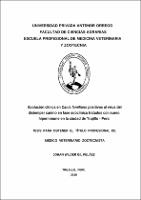Mostrar el registro sencillo del ítem
Evolución clínica en Canis familiaris positivos al virus del distemper canino en fase subclínica tratados con suero hiperinmune en la ciudad de Trujillo - Perú
| dc.contributor.advisor | Carvajal Mestanza, Francisco Abel | |
| dc.contributor.author | Gil Pelaez, Johan Wilder | |
| dc.creator | Gil Pelaez, Johan Wilder | |
| dc.date.accessioned | 2019-10-01T15:08:05Z | |
| dc.date.available | 2019-10-01T15:08:05Z | |
| dc.date.issued | 2019 | |
| dc.identifier.uri | https://hdl.handle.net/20.500.12759/5495 | |
| dc.description.abstract | El presente estudio se realizó en 15 caninos a los cuales se les inoculo el virus del distemper canino (VDC) reproduciéndose la sintomatología típica entre el cuarto y sexto día post inoculación manifestada con fiebre, rinorrea, secreción ocular, conjuntivitis y linfadenitis. Se consideró un grupo experimental (8 caninos) tratados con suero hiperinmune a partir del día 10 post infección y un grupo control (7 caninos) sin tratamiento. La evolución clínica de la enfermedad se evidencio con la aparición de sintomatología gastroenterológica a partir del día 10 post infección. En ambos grupos se presentó diarrea 87.5 % y 100%, melena 62.5% y 71.43%, dolor abdominal 50% y 100% para el grupo experimental y control respectivamente, toda la población en estudio manifestó vomito. Al día 17 post infección se evidenció la regresión paulatina de la sintomatología en los caninos del grupo experimental hasta su remisión total para el día 25 post infección y con una sobrevivencia del 100%, en contraste, los especímenes del grupo control progresaron hasta la aparición de sintomatología neurológica a partir del día 17 post infección, de progresión clínica ascendente hasta el día 20 post infección y posterior deceso mortal. | es_PE |
| dc.description.abstract | The present study was carried out in 15 canines inoculated with canine distemper virus (VDC), reproducing the typical symptomatology between the fourth and sixth day post inoculation manifested with fever, rhinorrhea, ocular secretion, conjunctivitis and lymphadenitis. An experimental group (8 canine) treated with hyperimmune serum from day 10 post infection and a control group (7 dogs) without treatment was considered. The clinical evolution of the disease was evidenced with the appearance of gastroenterological symptomatology from day 10 post infection. In both groups diarrhea presented 87.5% and 100%, melena 62.5% and 71.43%, abdominal pain 50% and 100% for the experimental group and control respectively, all the study population showed vomiting. At day 17 post infection the gradual regression of the symptomatology in the canines of the experimental group was evidenced until its total remission for day 25 post infection and with a survival of 100%, in contrast, the specimens of the control group progressed until the appearance of neurological symptomatology from day 17 post infection, from clinical progression up to day 20 post infection and subsequent death. | en_US |
| dc.description.uri | Tesis | es_PE |
| dc.format | application/pdf | es_PE |
| dc.language.iso | spa | es_PE |
| dc.publisher | Universidad Privada Antenor Orrego | es_PE |
| dc.relation.ispartofseries | T_MED.VETE_086 | |
| dc.rights | info:eu-repo/semantics/openAccess | es_PE |
| dc.rights.uri | https://creativecommons.org/licenses/by/4.0/ | es_PE |
| dc.source | Universidad Privada Antenor Orrego | es_PE |
| dc.source | Repositorio Institucional - UPAO | es_PE |
| dc.subject | Canis | es_PE |
| dc.subject | Hiperinmune | es_PE |
| dc.title | Evolución clínica en Canis familiaris positivos al virus del distemper canino en fase subclínica tratados con suero hiperinmune en la ciudad de Trujillo - Perú | es_PE |
| dc.type | info:eu-repo/semantics/bachelorThesis | es_PE |
| thesis.degree.level | Título Profesional | es_PE |
| thesis.degree.grantor | Universidad Privada Antenor Orrego. Facultad de Ciencias Agrarias | es_PE |
| thesis.degree.name | Médico Veterinario Zootecnista | es_PE |
| thesis.degree.discipline | Medicina Veterinaria y Zootecnia | es_PE |
| dc.subject.ocde | https://purl.org/pe-repo/ocde/ford#4.03.00 | es_PE |
| renati.type | https://purl.org/pe-repo/renati/type#tesis | es_PE |
| renati.level | https://purl.org/pe-repo/renati/level#tituloProfesional | es_PE |
| renati.discipline | 841056 | es_PE |
| dc.publisher.country | PE | es_PE |
Ficheros en el ítem
Este ítem aparece en la(s) siguiente(s) colección(es)
-
Veterinaria y Zootecnia [197]


